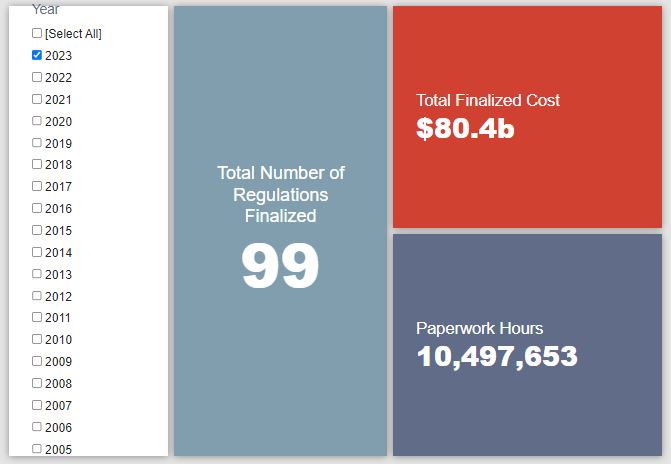Week in Regulation
July 17, 2023
Latest Round of Renewable Fuel Standards Drive Sizeable Week
Last week saw a modest volume of regulatory activity in the pages of the Federal Register. There were nine rulemakings with some measurable economic impact. The main item of the week was the latest Renewable Fuel Standard (RFS) rule from the Environmental Protection Agency (EPA). Across all rulemakings, agencies published $23.8 billion in total costs and added 176,397 annual paperwork burden hours.
REGULATORY TOPLINES
- Proposed Rules: 44
- Final Rules: 61
- 2023 Total Pages: 45,248
- 2023 Final Rule Costs: $80.4 billion
- 2023 Proposed Rule Costs: $322 billion
NOTABLE REGULATORY ACTIONS
The most significant rulemaking of the week was the EPA rule on “Renewable Fuel Standard (RFS) Program: Standards for 2023-2025 and Other Changes.” The rule is the latest iteration of a set of periodic rulemakings that “establishes the applicable volumes and percentage standards for 2023 through 2025 for cellulosic biofuel, biomass-based diesel, advanced biofuel, and total renewable fuel.” The rule also involves a nominal adjustment to a previous RFS rule due to issues it encountered under a D.C. Circuit Court opinion from 2017. As EPA notes in its cost analysis, “The biofuel costs are higher than the costs of the gasoline, diesel, and natural gas that they displace,” and thus the mandated usage of such fuels leads to higher fuel costs overall. EPA estimates that, over the three-year period this set of standards covers, the rule will involve roughly $23 billion in costs.
TRACKING THE ADMINISTRATIONS
As we have already seen from executive orders and memos, the Biden Administration will surely provide plenty of contrasts with the Trump Administration on the regulatory front. And while there is a general expectation that the current administration will seek to broadly restore Obama-esque regulatory actions, there will also be areas where it charts its own course. Since the AAF RegRodeo data extend back to 2005, it is possible to provide weekly updates on how the top-level trends of President Biden’s regulatory record track with those of his two most recent predecessors. The following table provides the cumulative totals of final rules containing some quantified economic impact from each administration through this point in their respective terms.![]() The RFS rule provided the bulk of the Biden Administration’s upward cost shift this past week. The current administration now stands at the cusp of $400 billion in terms of its to-date final rule cost total. The other covered administrations also saw plenty of action. The Trump-era cost total shot up by nearly $29 billion, mostly due to a Securities and Exchange Commission rule. A July 2011 Department of Health and Human Services rule implementing part of the Affordable Care Act was the primary reason for the Obama-era cost total increasing by $6 billion.
The RFS rule provided the bulk of the Biden Administration’s upward cost shift this past week. The current administration now stands at the cusp of $400 billion in terms of its to-date final rule cost total. The other covered administrations also saw plenty of action. The Trump-era cost total shot up by nearly $29 billion, mostly due to a Securities and Exchange Commission rule. A July 2011 Department of Health and Human Services rule implementing part of the Affordable Care Act was the primary reason for the Obama-era cost total increasing by $6 billion.
THIS WEEK’S REGULATORY PICTURE
This week, EPA finalizes its repeal of a Trump-era rule that would have further institutionalized cost-benefit considerations into the agency’s actions. Photo by Towfiqu barbhuiya on Unsplash
Photo by Towfiqu barbhuiya on Unsplash
Last Thursday, EPA published a final rule entitled “Rescinding the Rule on Increasing Consistency and Transparency in Considering Benefits and Costs in the Clean Air Act Rulemaking Process.” The straightforward title gives a good idea of the rulemaking’s purpose. The rule it rescinds is one from the waning weeks of the Trump Administration that sought to formally establish “procedural requirements governing the preparation, development, presentation, and consideration of benefit-cost analyses (BCA), including risk assessments used in the BCA, for significant rulemakings conducted under the CAA [Clean Air Act].”
In particular, the Trump-era rule would:
- Require a “BCA for all future significant proposed and final regulations under the CAA…except where the statutory provision or provisions under which a significant regulation is promulgated prohibit it”;
- Direct EPA to use “the best available scientific information and in accordance with best practices from the economic, engineering, physical, and biological sciences”; and
- Impose “additional procedural requirements to increase transparency in the presentation and consideration of the BCA results.”
In sum, the Trump-era EPA claimed: “Together, these requirements will help ensure that the EPA implements its statutory obligations under the CAA with high quality regulations in a way that is consistent and transparent and that these procedures are made enforceable upon the Agency.”
Fast-forward to today’s EPA and that sentiment is quite different. In the recission rule’s opening summary, the agency states: “The EPA is rescinding the rule because the changes advanced by the rule were inadvisable, untethered to the Clean Air Act, and not necessary to effectuate the purposes of the Act.”
This is all hardly surprising to say the least; the differences between the two administrations’ regulatory approaches have been clear for some time. Nevertheless, the rule – which has technically been in effect since a May 2021 interim final rule on the issue – becoming final provides the opportunity to once again examine just how stark that contrast between the two administrations has been.
TOTAL BURDENS
Since January 1, the federal government has published $402.4 billion in total net costs (with $80.4 billion in new costs from finalized rules) and 151.4 million hours of net annual paperwork burden increases (with 10.5 million hours in increases from final rules).











